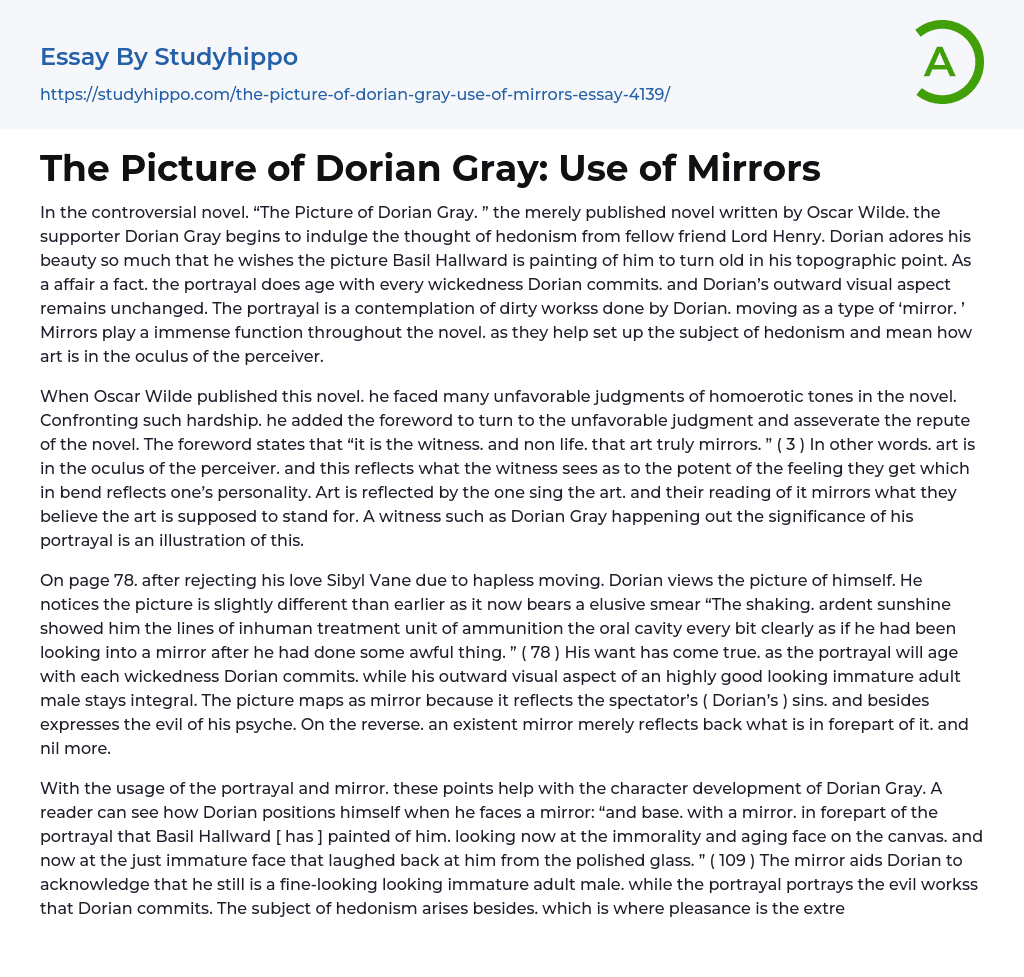In the controversial novel. “The Picture of Dorian Gray. ” the merely published novel written by Oscar Wilde. the supporter Dorian Gray begins to indulge the thought of hedonism from fellow friend Lord Henry. Dorian adores his beauty so much that he wishes the picture Basil Hallward is painting of him to turn old in his topographic point. As a affair a fact. the portrayal does age with every wickedness Dorian commits. and Dorian’s outward visual aspect remains unchanged. The portrayal is a contemplation of dirty workss done by Dorian. moving as a type of ‘mirror. ’ Mirrors play a immense function throughout the novel. as they help set up the subject of hedonism and mean how art is in the oculus of the perceiver.
When Oscar Wilde published this novel. he faced many un
...favorable judgments of homoerotic tones in the novel. Confronting such hardship. he added the foreword to turn to the unfavorable judgment and asseverate the repute of the novel. The foreword states that “it is the witness. and non life. that art truly mirrors. ” ( 3 ) In other words. art is in the oculus of the perceiver. and this reflects what the witness sees as to the potent of the feeling they get which in bend reflects one’s personality. Art is reflected by the one sing the art. and their reading of it mirrors what they believe the art is supposed to stand for. A witness such as Dorian Gray happening out the significance of his portrayal is an illustration of this.
On page 78. after rejecting his love Sibyl Vane due to hapless moving. Dorian views the picture of himself. H
notices the picture is slightly different than earlier as it now bears a elusive smear “The shaking. ardent sunshine showed him the lines of inhuman treatment unit of ammunition the oral cavity every bit clearly as if he had been looking into a mirror after he had done some awful thing. ” ( 78 ) His want has come true. as the portrayal will age with each wickedness Dorian commits. while his outward visual aspect of an highly good looking immature adult male stays integral. The picture maps as mirror because it reflects the spectator’s ( Dorian’s ) sins. and besides expresses the evil of his psyche. On the reverse. an existent mirror merely reflects back what is in forepart of it. and nil more.
With the usage of the portrayal and mirror. these points help with the character development of Dorian Gray. A reader can see how Dorian positions himself when he faces a mirror: “and base. with a mirror. in forepart of the portrayal that Basil Hallward [ has ] painted of him. looking now at the immorality and aging face on the canvas. and now at the just immature face that laughed back at him from the polished glass. ” ( 109 ) The mirror aids Dorian to acknowledge that he still is a fine-looking looking immature adult male. while the portrayal portrays the evil workss that Dorian commits. The subject of hedonism arises besides. which is where pleasance is the extreme of import end in life. and Dorian seeks this pleasance from his visual aspect and can accomplish this by looking at a mirror.
Hedonism is a major subject in the novel. and
mirrors help to set up and keep this subject throughout the book. Character development is besides acknowledged through the usage of mirrors. every bit good as how art is in the oculus of the perceiver which is described in the foreword. The art is in the oculus of the perceiver phrase is fascinating. as Oscar Wilde’s book is controversial confronting monolithic unfavorable judgments. such as people concerned with homosexualism. during the publication of his book. The phrase within the foreword refering mirrors helps shed visible radiation on the contention associated with the book. Mirrors reflect us. yet as portrayed in this book they can reflect our inner ego.
Plants Cited
Wilde. Oscar. The Picture of Dorian Gray. New York: Oxford University Press. 1998.
- Book Summary essays
- Metaphor essays
- Reader essays
- Rhyme essays
- Literary devices essays
- Villain essays
- Books essays
- Genre essays
- Literary Criticism essays
- Writer essays
- Protagonist essays
- Simile essays
- Poem essays
- Book Report essays
- Book Review essays
- Greek Mythology essays
- Plot essays
- Tragic Hero essays
- Coming of Age essays
- Play essays
- Rhetoric essays
- Rhetorical Question essays
- Translation essays
- Understanding essays
- Reason essays
- Character essays
- Letter essays
- American Literature essays
- Literature Review essays
- Utopia essays
- Poetry Analysis essays
- Dante's Inferno essays
- Between The World and Me essays
- Incidents in The Life of a Slave Girl essays
- Flowers for Algernon essays
- Myth essays
- Everyday Use essays
- Boo Radley essays
- Genesis essays
- Richard iii essays
- Alice in Wonderland essays
- On the road essays
- Ozymandias essays
- The Nightingale essays
- Holden Caulfield essays
- Animal Farm essays
- 1984 essays
- A Hanging essays
- Shooting An Elephant essays
- A Tale Of Two Cities essays




